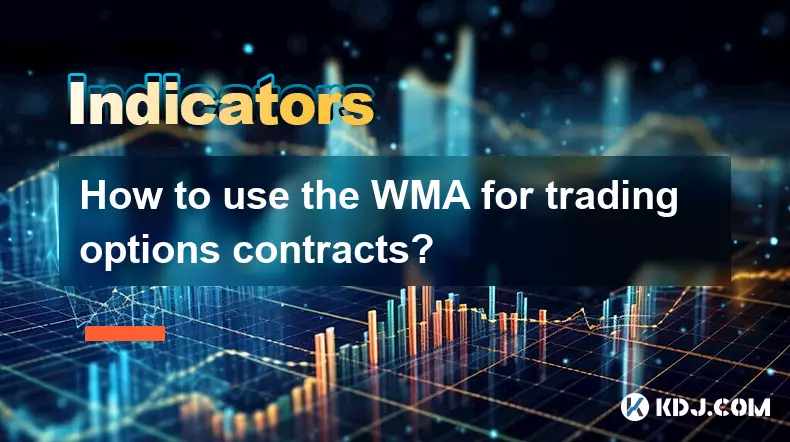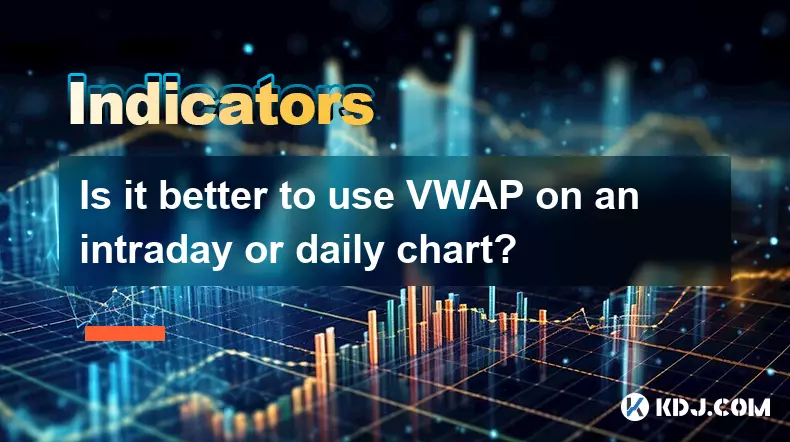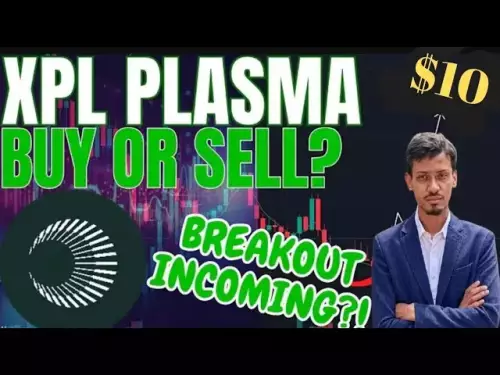-
 bitcoin
bitcoin $110918.433029 USD
-1.69% -
 ethereum
ethereum $3996.872473 USD
-2.43% -
 tether
tether $1.000594 USD
0.00% -
 bnb
bnb $1178.871834 USD
-2.38% -
 xrp
xrp $2.413973 USD
-3.47% -
 solana
solana $194.341461 USD
-4.24% -
 usd-coin
usd-coin $0.999963 USD
-0.03% -
 tron
tron $0.320092 USD
0.92% -
 dogecoin
dogecoin $0.196919 USD
-3.42% -
 cardano
cardano $0.669585 USD
-3.63% -
 hyperliquid
hyperliquid $37.485952 USD
-3.58% -
 ethena-usde
ethena-usde $1.000026 USD
-0.02% -
 chainlink
chainlink $18.018220 USD
-5.13% -
 bitcoin-cash
bitcoin-cash $523.879267 USD
-2.41% -
 stellar
stellar $0.324655 USD
-3.67%
How to use the WMA for trading options contracts?
The Weighted Moving Average (WMA) enhances options trading by prioritizing recent prices, improving timing for entries, exits, and strategy selection based on trend strength and volatility.
Oct 16, 2025 at 02:36 pm

Understanding the Weighted Moving Average in Options Trading
1. The Weighted Moving Average (WMA) assigns greater importance to recent price data, making it more responsive to new information compared to simple moving averages. This sensitivity is particularly useful when analyzing options contracts, where timing and volatility play crucial roles. Traders use WMA to identify momentum shifts and potential entry or exit points based on evolving price trends.
2. When applied to the underlying asset’s price—such as a stock or index—the WMA helps forecast short-term movements that directly impact options pricing. Since options derive their value from the underlying instrument, accurate predictions of price direction enhance the effectiveness of call and put strategies. A rising WMA suggests bullish momentum, favoring call options, while a declining WMA may signal bearish conditions, supporting put positions.
3. One common approach involves overlaying multiple WMA periods—such as 10-day and 30-day WMAs—on a price chart. Crossovers between these lines can trigger trading signals. For instance, when the shorter WMA crosses above the longer one, it may indicate a favorable environment for buying call options with near-term expiration dates.
Integrating WMA with Volatility Analysis
4. Options pricing is heavily influenced by implied volatility, which reflects market expectations of future price swings. By combining WMA readings with volatility indicators like Bollinger Bands or the VIX, traders gain deeper insight into whether an asset is likely to experience sustained movement or consolidation. A steeply sloped WMA during high-volatility phases suggests strong directional bias, increasing the probability of profitable options trades.
5. During periods of low volatility, the WMA tends to flatten, indicating limited price momentum. In such scenarios, neutral strategies like iron condors or butterfly spreads might be preferred over directional bets. However, if the WMA begins to turn upward while volatility remains suppressed, it could foreshadow an upcoming breakout, prompting early positioning in out-of-the-money options to capitalize on leverage.
6. Traders also monitor divergence between price action and the WMA. If the underlying asset reaches new highs but the WMA fails to confirm with a corresponding rise, this bearish divergence may warn of weakening momentum. Such conditions can justify purchasing put options as a hedge or speculative play, especially ahead of earnings reports or macroeconomic announcements.
Using WMA for Entry and Exit Timing
7. Precise timing is essential in options trading due to time decay (theta). The WMA serves as a dynamic benchmark for determining optimal entry points. For example, buying a call option when the price closes above a rising 20-day WMA increases the likelihood of riding an established uptrend before expiration erodes premium value.
8. Exits can be guided by WMA reversals. If the price drops below the WMA after a sustained move, it may signal deteriorating support and prompt closure of long call positions. Similarly, short put positions can be closed when the WMA turns upward, reducing exposure to adverse moves.
9. Some traders combine WMA with volume-weighted metrics to validate signals. High trading volume accompanying a WMA crossover adds credibility to the generated trade setup, reducing false positives. This is especially relevant in cryptocurrency options, where price manipulation and thin liquidity can distort technical patterns.
Adapting WMA Strategies Across Option Types
10. For binary options, where outcomes depend strictly on price direction at expiration, WMA trends provide clear decision frameworks. A consistently positive slope over the contract period supports 'call' selections, whereas downward trends favor 'put' choices.
11. In volatile markets like crypto derivatives, short-term WMA settings (e.g., 5-period) help navigate rapid swings. Day traders often use these fast WMAs on hourly charts to enter weekly or daily expiry options, aligning entries with intraday momentum surges.
12. For LEAPS (Long-Term Equity Anticipation Securities), longer WMAs such as 50-day or 100-day are more appropriate. These extended timelines require confirmation of structural trends rather than noise-driven fluctuations. A steadily ascending WMA across months validates bullish sentiment, justifying long-term call purchases with lower gamma risk.
Frequently Asked Questions
What is the ideal WMA period for trading weekly options? A 10-day WMA is commonly used for weekly options as it balances responsiveness and reliability. It captures recent momentum without being overly sensitive to minor price changes, making it suitable for short-duration contracts.
Can WMA be combined with the Greeks for better trade decisions? Yes. Delta values can be cross-referenced with WMA trends. High delta calls aligned with an upward-sloping WMA offer higher probability of finishing in-the-money. Theta decay can be managed by entering such trades when the WMA confirms strong momentum, maximizing time efficiency.
How does WMA perform in ranging markets for options selling? In sideways markets, the WMA flattens and price oscillates around it. This behavior supports non-directional strategies like credit spreads or strangles, where sellers collect premium while expecting minimal net movement beyond WMA boundaries.
Is WMA effective for American-style options? Absolutely. The early exercise feature of American options benefits from timely signals. WMA crossovers help determine not only entry but also optimal early exit or exercise points, particularly for deep in-the-money calls approaching dividends or corporate events.
Disclaimer:info@kdj.com
The information provided is not trading advice. kdj.com does not assume any responsibility for any investments made based on the information provided in this article. Cryptocurrencies are highly volatile and it is highly recommended that you invest with caution after thorough research!
If you believe that the content used on this website infringes your copyright, please contact us immediately (info@kdj.com) and we will delete it promptly.
- Cryptos in Flux: MoonBull's Lunar Stampede, Solana's Struggle, and XRP's ETF Hopes
- 2025-10-17 06:25:11
- Cardone Capital Dives Deeper: Why Grant Cardone is Buying More Bitcoin Now
- 2025-10-17 06:25:11
- Gold vs. Bitcoin: Navigating Market Volatility Like a New Yorker
- 2025-10-17 06:30:02
- Low Cap Crypto Gems Primed for 2025 Growth: Undervalued Coins to Watch
- 2025-10-17 06:30:02
- DOGE, AlphaPepe, and the Crypto Explosion: What's Next?
- 2025-10-17 04:25:14
- Dogecoin, Bitcoin, and Ethereum: Navigating the Crypto Current
- 2025-10-17 04:25:14
Related knowledge

What's the main difference between VWAP and TWAP?
Oct 12,2025 at 11:54am
Understanding VWAP and Its Role in Crypto Trading1. Volume Weighted Average Price (VWAP) is a trading benchmark that calculates the average price of a...

How do you identify exhaustion moves using VWAP and its bands?
Oct 12,2025 at 08:00am
Understanding the Role of Decentralized Exchanges in Crypto Trading1. Decentralized exchanges (DEXs) operate without a central authority, allowing use...

Is it better to use VWAP on an intraday or daily chart?
Oct 15,2025 at 02:01am
Intraday Trading and the Role of VWAP1. Intraday traders frequently rely on VWAP (Volume Weighted Average Price) as a dynamic benchmark for assessing ...

How do you use VWAP to scale in and out of positions?
Oct 14,2025 at 02:19am
Understanding VWAP as a Dynamic Benchmark1. The Volume Weighted Average Price (VWAP) is not just an indicator—it functions as a dynamic benchmark that...

What are the main advantages of using VWAP over EMA?
Oct 11,2025 at 02:18am
Main Advantages of Using VWAP Over EMA1. Volume-Weighted Average Price (VWAP) incorporates trading volume into its calculation, offering a more accura...

How do you use VWAP on different chart types like Heikin Ashi?
Oct 11,2025 at 05:01pm
Understanding VWAP in the Context of Heikin Ashi Charts1. The Volume Weighted Average Price (VWAP) is a powerful analytical tool commonly used by trad...

What's the main difference between VWAP and TWAP?
Oct 12,2025 at 11:54am
Understanding VWAP and Its Role in Crypto Trading1. Volume Weighted Average Price (VWAP) is a trading benchmark that calculates the average price of a...

How do you identify exhaustion moves using VWAP and its bands?
Oct 12,2025 at 08:00am
Understanding the Role of Decentralized Exchanges in Crypto Trading1. Decentralized exchanges (DEXs) operate without a central authority, allowing use...

Is it better to use VWAP on an intraday or daily chart?
Oct 15,2025 at 02:01am
Intraday Trading and the Role of VWAP1. Intraday traders frequently rely on VWAP (Volume Weighted Average Price) as a dynamic benchmark for assessing ...

How do you use VWAP to scale in and out of positions?
Oct 14,2025 at 02:19am
Understanding VWAP as a Dynamic Benchmark1. The Volume Weighted Average Price (VWAP) is not just an indicator—it functions as a dynamic benchmark that...

What are the main advantages of using VWAP over EMA?
Oct 11,2025 at 02:18am
Main Advantages of Using VWAP Over EMA1. Volume-Weighted Average Price (VWAP) incorporates trading volume into its calculation, offering a more accura...

How do you use VWAP on different chart types like Heikin Ashi?
Oct 11,2025 at 05:01pm
Understanding VWAP in the Context of Heikin Ashi Charts1. The Volume Weighted Average Price (VWAP) is a powerful analytical tool commonly used by trad...
See all articles










































































